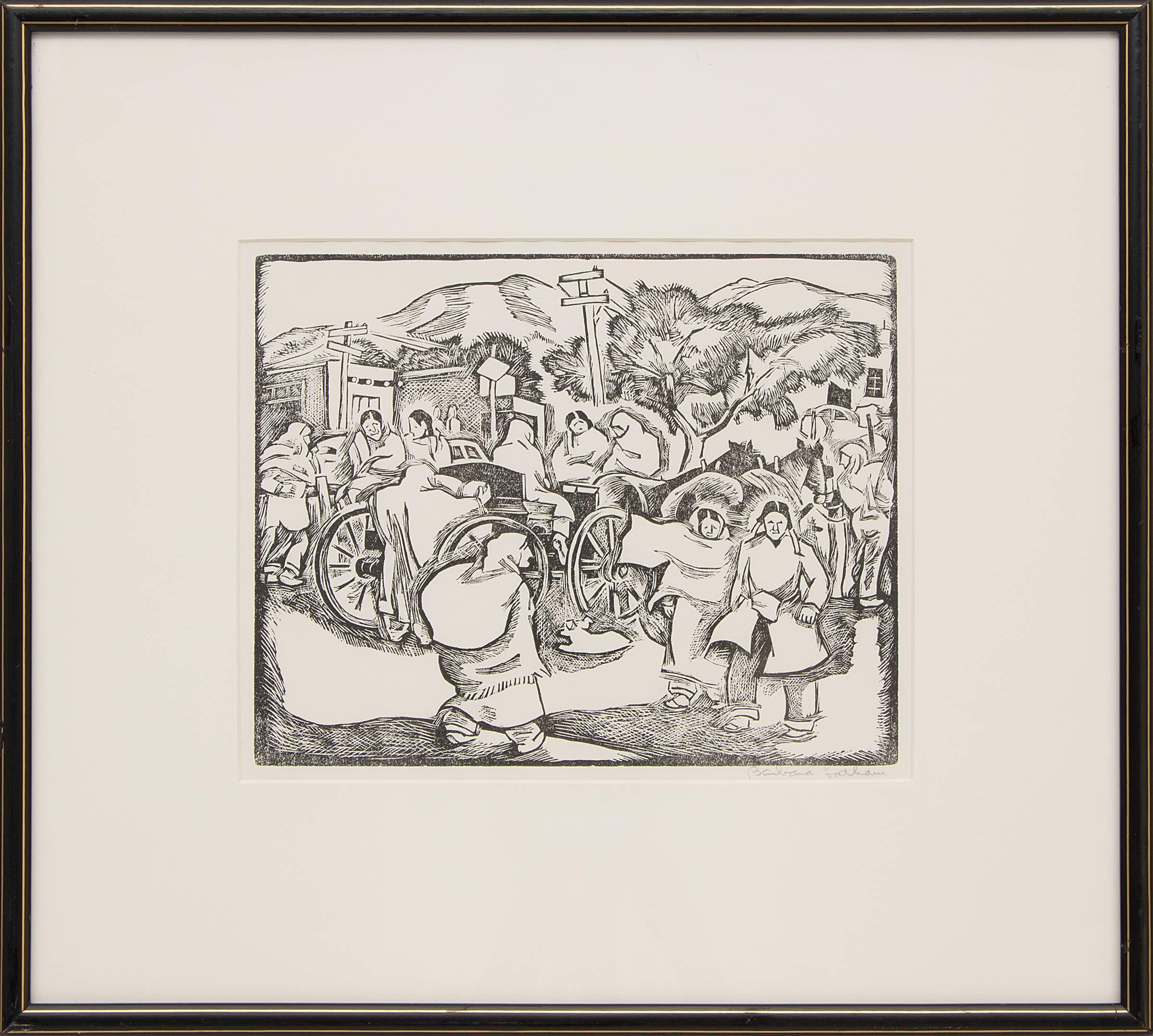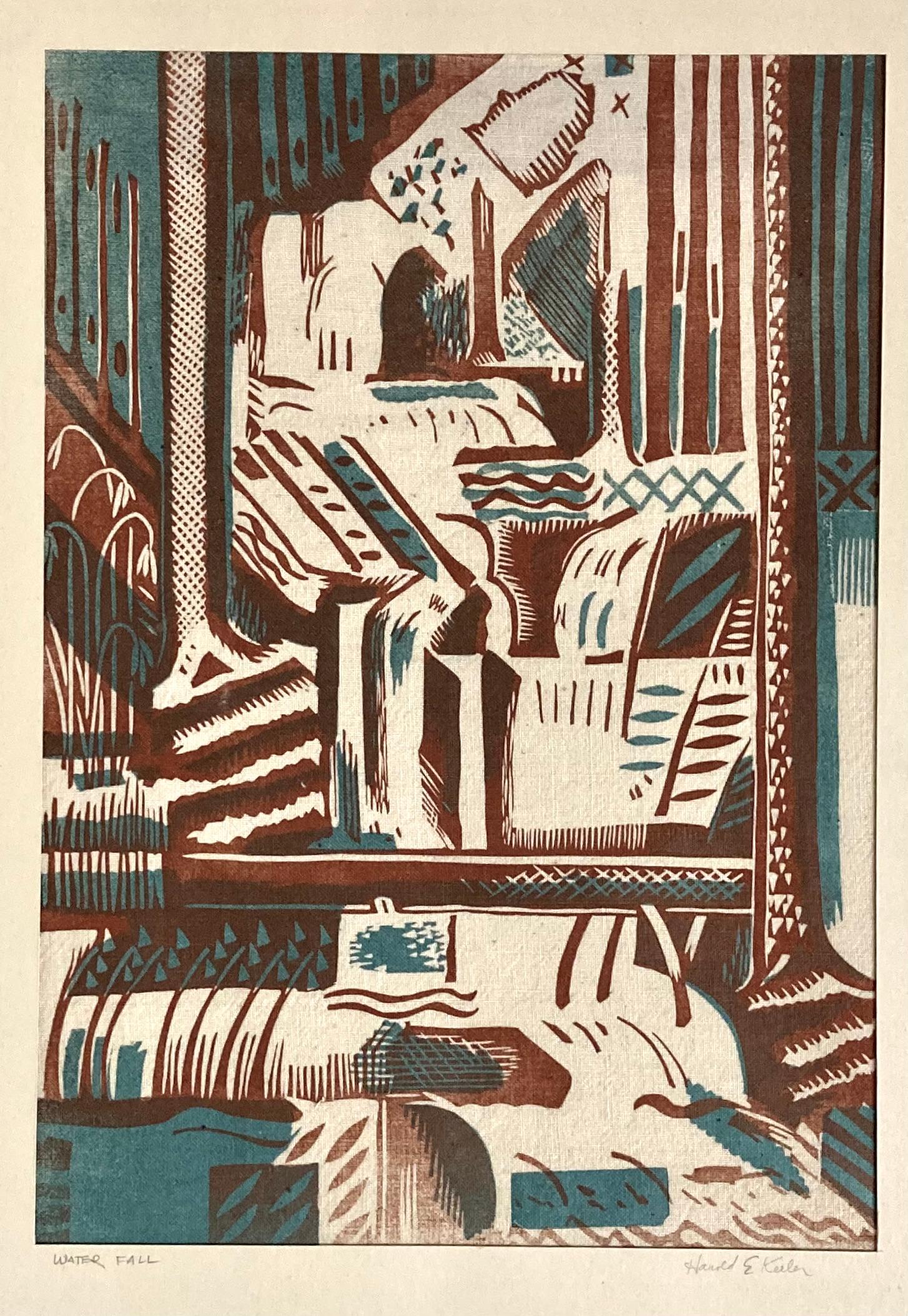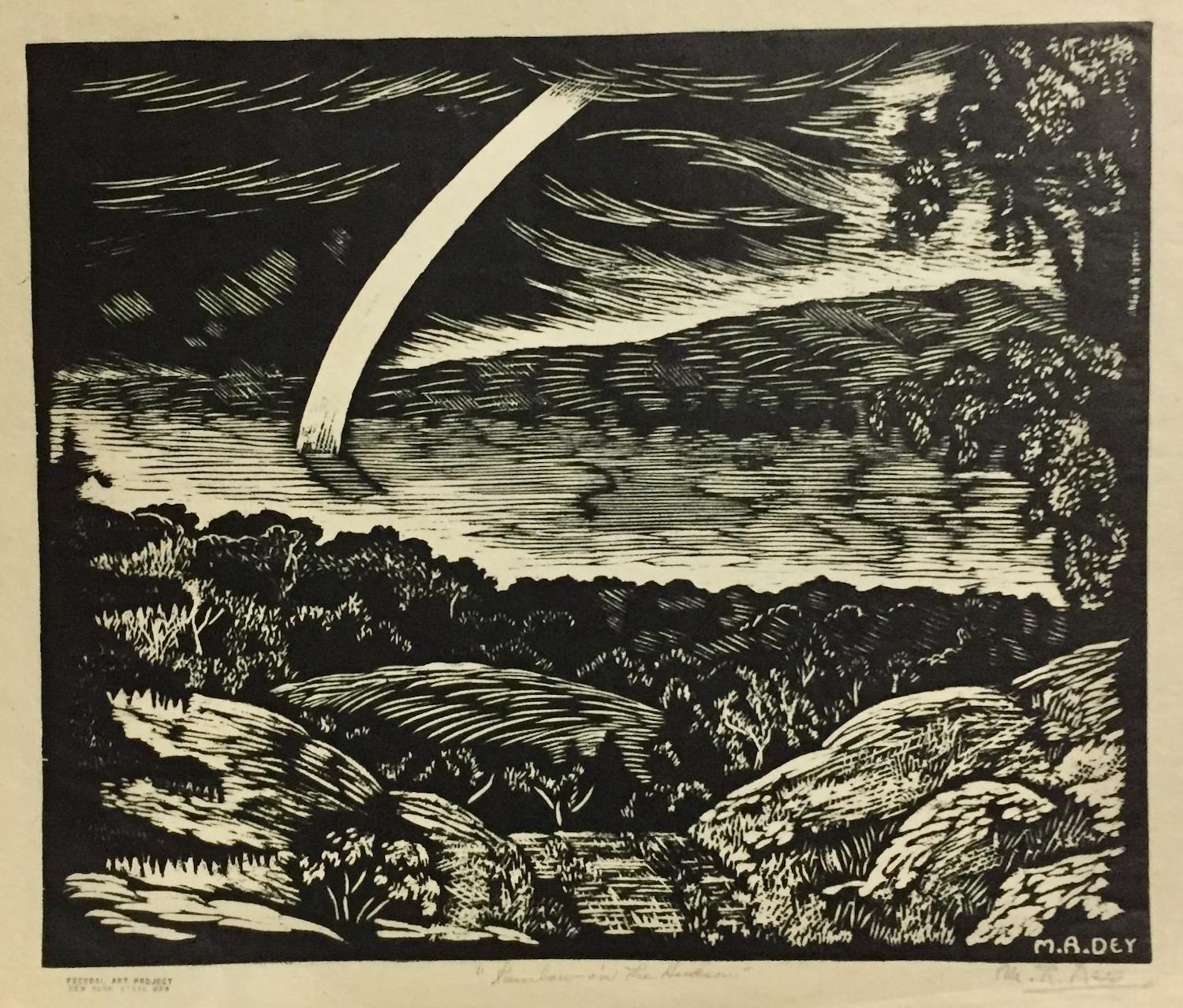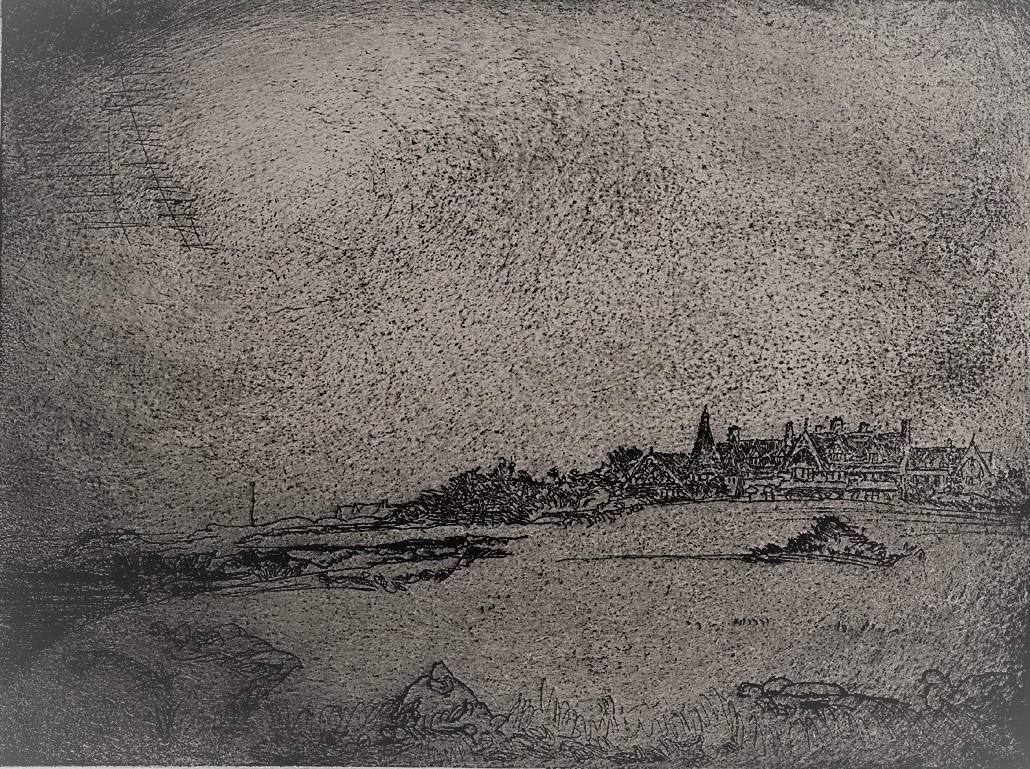Items Similar to 'Monday in Wick Haven' original linoleum cut print by Howard Thomas
Want more images or videos?
Request additional images or videos from the seller
1 of 8
Howard Thomas'Monday in Wick Haven' original linoleum cut print by Howard Thomas1936
1936
About the Item
In this image, Howard Thomas presents the viewer with a domestic interior. The image is dominated by the figure of a black woman, resting her arm on an ironing board. To the right, the tool of her task dangles a chord above a checker tiled floor. Beyond, though a window, neighboring homes fill the landscape. The careful line-work of the linocut adds a sense of expressionism to the scene, but the image nonetheless falls into the Social Realism that captivated most American artists during the Great Depression.
This print was published in 1936 as part of the Wisconsin Artists' Calendar for the year 1937, which included 52 original, hand-made prints – one for each week of the year.
6 x 5 inches, image
10 x 7.13 inches, sheet
12.37 x 12.43 inches, frame
Entitled "Monday in Wick Haven" lower left (covered by matting)
Inscribed "Linoleum Cut" lower center (covered by matting)
Artist name "Howard Thomas" lower right (covered by matting)
Framed to conservation standards using 100 percent rag matting and museum glass, all housed in a silver gilded moulding.
Quaker-born in Ohio, Thomas trained in the Midwest at Ohio State University and the Chicago Art Institute. He taught in the Art Department of the Milwaukee State Teachers College (now University of Wisconsin-Milwaukee) where he became good friends with Carl Holty, Edward Boerner, Robert von Neumann and Gustave Moeller.
Thomas was a painter of the American scene from the beginning of his career to the mid 1940s. He had been investigating cubism during the mid-to-late 1930s. Thomas made his first trip to the South for a speaking engagement in 1941 and the red earth around Asheville, North Carolina interested him. Thus began his use of earth as a pigment source. In the tradition of old masters, he used mortar and pestle to mix his pigments. Thomas sought natural materials from wherever he traveled around the world and kept a concise diary with painting codes of the gritty earth pigments and dense earth colors for his paintings.
After 1942, Thomas worked permanently in the South. He was an enthusiastic teacher at the University of North Carolina, Greensboro (1942-43), Agnes Scott College, Decatur, Georgia (1943-45) and the University of Georgia where he arranged for Carl Holty, an authority on modern painting, to become artist-in-residence. The “transformation” in Thomas’ painting was the result of interaction with Holty. His progression from regionalist imagery of the 1930s to abstract imagery of the 1950s was done with great deliberation. Thomas gradually eliminated the ideas of foreground and background. Thomas consistently used music as an impetus for his painting. He placed the surface to be painted on the floor and worked with sweeping rhythmic movements to Bach, Vivaldi or Haydn.
Although Thomas painted in the South after 1942, his Milwaukee association had shaped the most important concepts of his intellectual and artistic maturation, especially his exceptional visual memory. He was also a member of the Wisconsin Painters & Sculptors. [Biography via the Museum of Wisconsin Art online archive]
- Creator:Howard Thomas (1899 - 1971, American)
- Creation Year:1936
- Dimensions:Height: 12.37 in (31.42 cm)Width: 12.43 in (31.58 cm)
- Medium:
- Movement & Style:
- Period:
- Condition:
- Gallery Location:Milwaukee, WI
- Reference Number:
About the Seller
4.9
Platinum Seller
These expertly vetted sellers are 1stDibs' most experienced sellers and are rated highest by our customers.
Established in 1966
1stDibs seller since 2017
391 sales on 1stDibs
Typical response time: 1 hour
- ShippingRetrieving quote...Ships From: Milwaukee, WI
- Return PolicyThis item cannot be returned.
More From This SellerView All
- 'Jones Island' original woodcut engraving by Gerrit SinclairBy Gerrit SinclairLocated in Milwaukee, WIThe print 'Jones Island' is something of a self portrait. In the image, an artist stands before and easel, depicting the docks and buildings on the coast. The title indicates that this is Jones Island in Milwaukee, the peninsula along Lake Michigan that today is home to largely industrial buildings. The buildings and figures in the print suggest that this might be a view of the last of the Kashubian or German immigrant settlements on the peninsula before they were evicted in the 1940s to make way for the development of the harbor. The artist in the image thus acts as a documentarian of these peoples. The careful line-work of the woodblock engraving adds a sense of expressionism to the scene, leaving the figures and buildings looking distraught and dirty, though the image nonetheless falls into the Social Realist category that dominated American artists during the Great Depression. This print was published in 1936 as part of the Wisconsin Artists' Calendar for the year 1937, which included 52 original, hand-made prints – one for each week of the year. 6 x 5 inches, image 10 x 7.13 inches, sheet 13.43 x 12.43 inches, frame Signed "GS" in the print block,upper left Entitled "Jones Island" lower left (covered by matting) Inscribed "Wood Engraving" lower center (covered by matting) Artist name "Gerrit V. Sinclair" lower right (covered by matting) Framed to conservation standards using 100 percent rag matting and museum glass, all housed in a silver gilded moulding. Gerrit Sinclair studied at the Art Institute of Chicago from 1910 - 1915, under Vanderpoel, Norton, and Walcott. In World War I, he served in the Army Ambulance Corps and later recorded his experiences in a series of oil paintings. He taught in Minneapolis before arriving in Milwaukee in 1920 to become a member of the original faculty of the Layton School of Art. He was also a member of the Wisconsin Painters & Sculptors. Sinclair's paintings and drawings were executed in a lyrical, representational style, usually expressing a mood rather than a narrative. His paintings reveal a great sensitivity for color and atmosphere. His subject matter focused on cityscapes, industrial valleys, and working-class neighborhoods, captured from eye-level. A decade before the popularity of Regionalism, Sinclair's strong interest in the community was reflected not only in his paintings, but also in his encouragement to students to return to their communities as artists and teachers. Joseph Friebert...Category
1930s American Modern Figurative Prints
MaterialsWoodcut, Engraving
- 'Scene on the Wabush' original engraving by Wellstood & Kirk PottawatomiLocated in Milwaukee, WI"Scene on the Wabash, and Potawattamie Indians" is an original hand-colored engraving, executed by Wellstood & Kirk after the original painting by George Winter. The image captures the kind of scene of the American landscape for which Winter is best known: among the lush trees and flowing rivers, Pottawatomi men, women and children relax from their travels, their horses tied...Category
1860s Romantic Landscape Prints
MaterialsPaper, Engraving, Pigment, Watercolor
- 'Hyde Park' original woodcut engraving signed by Auguste Louis LepèreBy Auguste Louis LepèreLocated in Milwaukee, WIThe present artwork is an excellent example of the woodcut engravings of Auguste-Louis Lepère (1849 - 1918). He was the son of the sculptor Francois Lepère, and is considered a leade...Category
1860s Realist Figurative Prints
MaterialsWoodcut, Engraving
- 'May Day in the Country, ' original woodcut engraving by Winslow HomerBy Winslow HomerLocated in Milwaukee, WIThe present woodcut engraving is an original print designed by Winslow Homer, originally published in Harper's Weekly on April 30, 1859. It is an excellent example of the many prints Homer produced of fashionable people engaged in leisurely activities, in this case along a picturesque countryside lane. The sign reading 'Belmont' on the left indicates this is probably near his home in Belmont Massachusetts. The image presents multiple figures, both men and women, riding horseback: Some in the distance gallop away, toward a town marked by a church steeple beyond. Three others in the foreground, including two equestrian women, gather around a group of children who have been gathering flowers and trapping birds...Category
1850s Victorian Figurative Prints
MaterialsWoodcut, Engraving
- Toulouse Lautrec Original Lithograph Famous Political 1800s Collection SignedBy Henri de Toulouse-LautrecLocated in Milwaukee, WI"Lautrec Book: From Au Pied du Sinai written by Georges Clemenceau" lithographs created by the legendary Henri de Toulouse-Lautrec. This book, Au Pied...Category
1890s Post-Impressionist Figurative Prints
MaterialsLithograph, Mulberry Paper
- "Le Prince Iris, " Surrealist Lithograph From "Je Reve" PortfolioBy André MassonLocated in Milwaukee, WI"Le Prince Iris" is an original color lithograph by Andre Masson. The artist signed the piece lower right in pencil and wrote the edition number, H.C. XXV/X...Category
1970s Surrealist Figurative Prints
MaterialsLithograph
You May Also Like
- Saturday Morning (Market, Taos Plaza, New Mexico), 1950s Figural Linocut PrintBy Barbara LathamLocated in Denver, CO1950s modernist linoleum cut print titled 'Saturday Morning (Market, Taos Plaza, New Mexico) by New Mexican artist Barbara Latham. Depicting a busy Saturday morning at the market in Taos Pueblo with horse and cart, Native American figures, adobe buildings and mountains in the background. Presented in a custom frame with all archival materials, outer dimensions measure 16 x 17 ¾ inches. Image size is 8 ½ x 10 ½ inches. About the Artist: Beginning her career as a commercial artist, Barbara Latham travelled to Taos in 1925 seeking material for a greeting card. Serendipitously, she also found her life partner, Howard Cook, who was similarly looking for ideas for illustrations. Perhaps both were fueled in their quest by the tales of their mutual teacher, Andrew Dasburg, who knew of the energy and stimulation of this artist community. Observing local people and customs, Latham created genre scenes that offer a window into this now-vanished time and place. Her lively illustrations for numerous children's books are a significant contribution to that graphic art in the mid-20th century. Born in Walpole, Massachusetts, Latham's student days included Norwich Art School and Pratt Institute in Brooklyn; but it was contact with the charismatic Dasburg at the Art Students League in Woodstock that opened her world and her view of art. Getting work with companies like Norcross Publishing and Forum magazine, she eventually made her way to Taos. Among all the spirited young artists gathered there, she met Howard Cook, who was designing illustrations for Willa Cather's Death Comes to the Archbishop. The two married in Santa Fe and began a nomadic life together. The young couple made their way to Paris, a likely destination for modernist artists. Upon receiving a Guggenheim to study fresco painting in 1932, Cook, along with Latham, took an alternative direction and headed to Taxco, Mexico. At this time, Mexican muralists, such as Diego Rivera, were capturing the attention of progressive artists. During the Depression, both Cook and Latham aligned themselves with a populist ideal. Latham contributed work, such as "Fording the Stream" and "Bear Family," to the American Artists Group, which was founded to produce original prints at affordable prices. The couple also travelled in the Deep South to the Ozarks and to "Alabama's Black Belt." When Latham settled in Taos, she was committed to an art of and for the people. Rather than a romanticized re-creation, her choice of subjects was based in common everyday activities, favoring those which brought people together. Taos Pueblo was an ancient, indigenous community, and Latham's view extended that tradition into a contemporary, multi-ethnic village. Sharing some of the spirit of WPA photographs...Category
Mid-20th Century American Modern Figurative Prints
MaterialsLinocut
- Evelyn G. Schultz, TyphoonLocated in New York, NYThe only mention I can find of Evelyn G. Schultz is that she was a charter member of the San Diego Watercolor Society. But the medium of the linocut (here on tan paper) was frequentl...Category
1940s American Modern Figurative Prints
MaterialsLinocut
- Harold E. Keeler, Water FallLocated in New York, NYHarold E. Keeler worked in Hollywood as a set designer. That seems especially important here because the Water Fall looks a little as though it could be a woodland stage set -- to me...Category
1930s American Modern Landscape Prints
MaterialsLinocut
- Maurice Robert Dey, Rainbow on the HudsonLocated in New York, NYBiographical information on Maurice Robert Dey is hard to find. He was born on 1899 (or maybe 1900), in Switzerland. As an adult he lived and worked in Woodstock, the NY artists' c...Category
1930s American Modern Landscape Prints
MaterialsLinocut
- Into the Night (a lone male emerges from a subway stop by the Flatiron Building)By Frederick MershimerLocated in New Orleans, LAA lone figure emerges out of bright lights streaming from a subway entrance at the corner of 23rd and Broadway near the Flatiron Building and Madison Square Park. He has just exited the uptown...Category
Early 2000s American Modern Figurative Prints
MaterialsMezzotint
- House on Cliff Walk, Newport, Rhode IslandBy Clifford Isaac AddamsLocated in Storrs, CTHouse on Cliff Walk, Newport, R.I. 1931-1932. Etching and drypoint. Hausberg catalog 13 state .i/ii. Edition 75 in this state. 5 7/8 x 7 7/8 (sheet 9 x 13 1/2). A rich impression pr...Category
Mid-20th Century American Modern Landscape Prints
MaterialsDrypoint, Etching
Recently Viewed
View AllMore Ways To Browse
Thomas Vintage
Howard Vintage
Robert Thomas Paintings
Engraving Tool
Old Vintage Window Frames
1950s Tile Art
Checker Print
American Depression Glass
Old Vintage Hand Tools
Figural Tile
Black Mortars
Old Vintage Tiles
Old Vintage Tile Tiles
Von Standard
Framed Vintage Sheet Music
Black Floor Tile
Vintage Checker Board
Pestle And Mortar Used For





